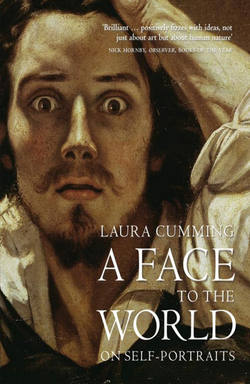A Face to the World: On Self-Portraits

Реклама. ООО «ЛитРес», ИНН: 7719571260.
Оглавление
Laura Cumming. A Face to the World: On Self-Portraits
LAURA CUMMING. A FACE TO THE WORLD. ON SELF-PORTRAITS
Dedication
Contents
Preface
1 Secrets
2 Eyes
3 Dürer
4 Motive, Means and Opportunity
5 Rembrandt
6 Behind the Scenes
7 Velázquez
8 Mirrors
9 Performance
10 Stage Fright
11 Loners
12 Egotists
13 Victims
14 Pioneers
15 Falling Apart
16 Farewells
Select Bibliography. On Bonnard
On Botticelli
On Caravaggio
On Carracci
On Courbet
On David
On De Chirico
On Degas
On Delacroix
On Dürer
On Gentileschi
On Goya
On Guston
On Klee
On La Tour
On Manet
On Mengs
On Michelangelo
On Munch
On Parmigianino
On Poussin
On Raeburn
On Rembrandt
On Reynolds
On Rosa
On Seurat
On Van Eyck
On Van Gogh
On Velázquez
On Vigée-Le Brun
Index
Select General Reading
Plates
Acknowledgements
Notes. Preface
Chapter I Secrets
Chapter 2 Eyes
Chapter 3 Dürer
Chapter 4 Motive, Means and Opportunity
Chapter 5 Rembrandt
Chapter 6 Behind the Scenes
Chapter 7 Velázquez
Chapter 8 Mirrors
Chapter 9 Performance
Chapter 10 Stage Fright
Chapter 11 Loners
Chapter 12 Egotists
Chapter 13 Victims
Chapter 14 Pioneers
Chapter 16 Farewells
Copyright
About the Publisher
Отрывок из книги
In memory of my father James Cumming
And for Elizabeth, Dennis, Hilla and Thea with all my heart
.....
The angel in the New Jerusalem, according to Revelation, has a rod to measure the glorious architecture of the city. The measurements of Van Eyck’s New Jerusalem are exceptionally small – the whole picture is only about two feet wide – and his rod is thus sensationally tiny, a microscopic yardstick for a miniature vision. But even without the biblical aside, and Van Eyck’s paintings are always theologically rich, the little man in his eye-catching turban has a modest humour all of his own: discreet enough to escape Rolin’s self-centred attentions, you feel, but there for those who have eyes to see him.
Van Eyck places himself at the crosshairs of his own field of vision; painting the world, and all its contents, he numbers himself within it. This is not narcissism but modest logic: even without a mirror, or reflections, we are visible to ourselves somewhat. Shut one eye and the projecting nose becomes apparent; look up and see the overhanging brow. We have an outer as well as an inner sense of our own bodies that reflections confirm or confound; and catching sight of these reflections, we are made episodically conscious of our own bodily existence – atoms in time, maybe, but nonetheless the viewing centre of our world.
.....